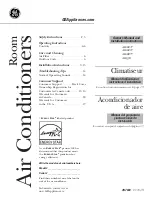
4. INSTALLATION
3.1 ACCESSORIES:
A. . . . . . . . . . . . . . . . . . . . . . SEAL PLATE ADAPTOR
B . . . . . . . . . . . . . . . . . ExHAUST DUCT (MAx. 1.5M)
C . . . . . . . . . . . . . . DRAINAGE HOSE CONNECTOR
D . . . . . . . . . . . . . . . . . . . . . . . . . . .DRAINAGE HOSE
E . . . . . . . . . . . . . . . . . . . . . . . . .REMOTE CONTROL
F . . . . . . . . . . . . SLIDING SEAL PLATE (ExHAUST)
4.1 Assembling the exhaust duct.
(See fig.3b) First extend each end of the duct (B) as shown above and attach the
seal plate adaptor (A) to one end using an anticlockwise threading action. Attach the other end of the duct directly
to the exhaust air outlet on the back of the unit (see fig.2-13), once again using an anticlockwise threading action.
The exhaust duct can be extended up to 1.5m. The unit is at its most efficient when the exhaust duct is kept as
short as possible. Use only the duct supplied. Do not further extend the length of the duct with other ducting as
this will reduce the efficiency of the unit.
4.2 Seal Plate placement.
See fig.3F. Identify a suitable window which can be vertically or horizontally opened.
Match the window opening to the height of the seal plate. Slide the inner part of the seal plate out until it matches
the width of the window and lock the two parts together by tightening the screws on the inside edge of the inner
slide. Permanently screw the seal plate to the window frame or make a semi permanent installation using
re-inforced, high tack, adhesive tape. Bring the unit close to the window and push the seal plate adaptor at the
end of the duct into the matching hole in the seal plate. Fig.5 shows the unit installed by a horizontally opening
window. Keep the duct as short as possible but do not allow the duct to be kinked or distorted or blocked as this
will overheat the unit. If the unit becomes overheated it will automatically shut down.
Original Language Version
SAC9000.V2 Issue No.1 19/01/10
Fig.3
Fig.4

























